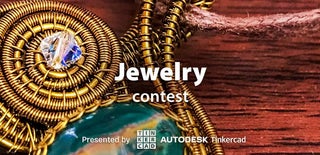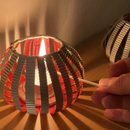Introduction: Soda Can Necklace
This tutorial shows you how to craft a beautiful necklace. It will be the modern piece in your collection and is made entirely by hand. Although it shines like solid 925 sterling silver it is made from 100% aluminum ... or at least 100% of what soda cans are made from. This project to repurpose beverage cans as jewelry is explained in the first video (see chapter Supplies).
The necklace weighs next to nothing and features a purchased magnetic clasp. As an alternative to make the necklace even lighter, a clasp was designed using the Tinkercad 3D software. The design was then printed with PLA using a 3D printer and attached to the necklace. The corresponding files are attached to this Instructable (chapter 8). The process using Tinkercad is shown in the second video (see chapter Supplies).
The tutorial uses some of the techniques I've explained before on Instructables, specifically how to make a strip cutter for soda cans. The aluminum strips from the strip cutter are wrapped crosswise around a thin rod. Then you need to heat the aluminum strips in an oven. This will assure that the strips keep the permanent shape when you pull them off the rod. Lastly, all you have to do is attach the clasp.
I hope you like this innovative and creative way to recycle soda cans and turn them into a unique piece of jewelry - so please support me in the jewelry contest.
Supplies
In order to realize this project you need the following:
- Aluminum rod (diameter 6 mm, maximal length depends on the size of your oven, mine is 67 centimeter)
- Two soda cans (0.5 Liter)
- Silicon tubing (5 cm) with same diameter like the aluminum rod
- Super glue
- Magnetic Clasps Silver Tone, 7mm (Link)
- Completely optional (smile): Jewelry stand (Link)
This project is based on the following Instructables:
Step 1: Ink Removal From Soda Can
Before you start, remove the imprints on the outside wall of the soda can. I already posted an Instructable that demonstrates an easy method for ink removal from soda cans. I was the first one publishing this procedure on November 8th, 2016. You can find the Instructable here: Link.
Step 2: Use Soda Can Strip Cutter
Maybe you are familiar with strip cutters that have been made for PET bottles. They are using a sharp knife to cut the material into a long strip. This principle cannot be used for soda cans. Even though the aluminum from cans is very thin, it is not feasible with regular tools laying around the house. The trick here is to score the can very lightly in a spiral way with a knife blade. After that, the strip can be pulled off. The entire process is shown here: Link ........by the way, I was the first to show this procedure on the internet here too.
As you can see in the attached video, I no longer use the tools I showed in the corresponding tutorial. Instead, I made some 3D printed parts to cut strips to make the process easier. If there is enough interest, I might feature these parts in an Instructable. Please leave a comment below if I should do so.
Step 3: Wrap Aluminum Strip Around Rod
First, we need a straight rod with a fine surface which can withstand the heat in an oven. I took an aluminum rod with a diameter of 6 mm. Around this rod we wrap the aluminum strips. In order to attach the strip at the beginning and end of the rod, saw a slit in the rod on both sides.
Now we bend the first strip into the slot and begin to wrap the strip around the rod.
When starting with the first strip - it is not not wound overlapping. Always leave a small space between each turn. After two or three turns, push the strip together with your thumb so that there is no more space. It is best to watch the process in the video (see chapter Supplies).
When you get to the other end of the rod, secure the strip in the slot and bend it back. The second strip is also fixed in the slot, but the winding of the strip follows crosswise to the first strip. Again, wrap the strip around the rod until the end.
If the strip used is too short for the rod and fixing it in the slot is not possible, you can use copper wire. To do this, punch a hole in the strip with a needle and attach copper wire in it. Then wrap the wire around the rod so that the strip can not move. Only the visible strip on the outside was freed from the ink of the can. The strip used for the inside is from an unprepared can.
The inner strip is wound with the ink against the rod. Only in this way, after the oven, the chain can be easily detached from the rod. If you take the inside of the can (the side facing the beverage) then the protective paint can stick to the aluminum and you can not get the chain away.
Step 4: Fix Aluminum Strip in Oven
Place the rod with the strips in an oven. Heat it up to 200°C (392°F) for 30 minutes. This will make the strips keep their shape when you pull them off the rod. Thereafter cool it down by holding it under cold water.
Step 5: Release Necklace From Rod
Cut off the ends of the strips that were inserted into the slot of the aluminum rod. Then carefully detach the chain from the rod. When you bend the chain between your fingers, it feels like a rubber band - very elastic. Very interesting when you consider that it was previously a rigid beverage can.
Step 6: Cut Necklace to Correct Length
The length of the necklace depends on the length of the rod you have. The rod can only be of such a length that it fits into the oven. My rod is 67 centimeters long with a diameter of 0.5 centimeter and it fits diagonally in the oven. You can easily cut the chain to the desired length with scissors.
Step 7: Necklace Magnetic Clasps
The chain itself is of course somewhat fragile and can be easily dented. Therefore, we need a small reinforcement where the clasp is attached so we can open and close it with our fingers. For this, we take some silicone tubing.
First, we insert a small piece of silicone tube into the end of the chain and add super glue. Then you put super glue on the outside and put the clasp over it.
Step 8: Necklace Clasp Designed With Tinkercad and 3D Printed
I created a separate video showing how I drew the clasp in Tinkercad (see chapter Supplies) - so please watch the video. In the picture above you can see the two clasp models next to each other. Of course, the PLA clasp would need some color to lock better but this was the only filament I had laying around.
In the end, the drawing was exported and then sliced with the PrucaSlicer. The file was transferred to a USB stick and uploaded to the 3D printer ........ did I already mentioned that I love my Prusa MINI? For a long time I tried not to buy such a device. I always told myself to focus on a drawing program and have the design printed externally. At a certain point, I couldn't resist anymore and bought one that really is "plug and play" or at least "plug and print". The files are attached below.
Step 9: Final Product
After having finished the necklace ... some additional details:
In the picture with the blue background you can see a chain where the inside of a can was used as the outside for the chain. This is the variant where you do not have to remove the paint. This necklace lacks the metallic shine and looks rather matte, but still attractive. If you feel that you do not want the aluminum directly on the skin, use this variant.
A chain with the color against the outside I have not yet tried.
In the picture with the green background you can see a chain where a strip with a width of 5 mm was used. This one is of course much more flexible then the one in the picture with the blue background (9 mm).
Besides using it as a necklace, you can also use this chain to shield electrical cables. Hope you like this Instructable.

Participated in the
Jewelry Contest














